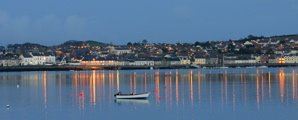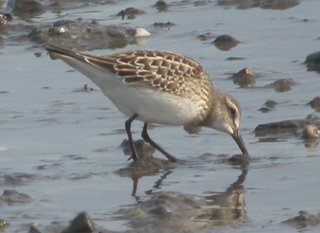On Saturday I had a text from Derek Charles saying that he had seen two White Rumped Sandpipers on the outer Ards Peninsular at a place called Cloghy.
 Click on Image for larger picture. I was exhausted after the week and went home after work to bed, for most of the afternoon. I was hoping they would be there on Sunday. Sunday came and went with very little birding done. I picked up my new to me but old VW passat estate with 100k miles on it. As I drive around six hundred miles a week it was costing me a small fortune in petrol in my Subaru so had to change to a more economical diesel. At least I will be getting 600 miles to a tank as opposed to 350.
Click on Image for larger picture. I was exhausted after the week and went home after work to bed, for most of the afternoon. I was hoping they would be there on Sunday. Sunday came and went with very little birding done. I picked up my new to me but old VW passat estate with 100k miles on it. As I drive around six hundred miles a week it was costing me a small fortune in petrol in my Subaru so had to change to a more economical diesel. At least I will be getting 600 miles to a tank as opposed to 350.I listened to flightline at about three am this morning and they were reported to be still there. After work I went home and received a text from Anthony to say they were there this morning. So I headed down to Strangford to catch the ferry
 across to Portaferry
across to Portaferry While I was on the ferry I read up about the W-R Sandpiper and looked at illustrations. Anthony also rang me and gave me a good description.
While I was on the ferry I read up about the W-R Sandpiper and looked at illustrations. Anthony also rang me and gave me a good description.I then drove over to Cloghy and the road was being dug up right alongside the shore so I parked up beyond the diggers and wound down the window looked at the first bird that caught my eye and blow me it was the White-rumped Sandpiper.
 Photo by Derek Charles
Photo by Derek CharlesAt this stage it was only 20-30 feet from me. I got my telescope out to really learn about the detail of the bird. Then I thought I would phonescope it; Not to be! at the moment I put phone to scope digger revved its engine and bird flew off and landed a few hundred yards away amongst about twenty Dunlin and Thirty Ringed Plover. I had great difficulty picking it out from then on. Not helped by the fact a Kestrel flew overhead a couple of times putting them all to flight. There was a nice Bar Tailed Godwit on the beach as well.
I then went to Ballyquintin Point National Nature Reserve.Wild, windswept and remote, Ballyquintin Point forms the southern tip of the Ards Peninsula. It lies on a low, exposed, rocky coastline consisting of small promontories, bays, inlets and islands. The point is formed by a raised beach of shingle and cobble stones, gently sloping inland to low cliffs. Such deep banks of raised beach shingle, vestiges from the last ice-age, are found nowhere else around the Ulster coast.
Thin soils support only sparse, dry grassland which briefly comes to life in May and June with a colourful display of wild flowers. Patches of low-growing burnet rose flower profusely from May to July and produce their unusual, purple hips soon after. Curious wind-dwarfed blackthorn scrub survives on the exposed cobbles, barely twelve inches high. The undisturbed cobbles on the surface are covered in an intriguing patchwork of lichens, in shades of grey and sometimes yellow, resembling an ancient map. Pockets of saltmarsh nestle amongst the mosaic of rocky outcrops and shingle towards the shore.
Gorse or whin provides excellent cover and nesting opportunities for stonechats, whitethroats and linnets. The point is a good spot to see Irish hares, which feed on the grassland and along the shoreline. Migrant butterflies such as Red Admirals cross the Irish Sea and can be abundant here in some years.
Well bizarrely I have lived within five miles as the crow flies of this spot (see map above) for sixteen years and have never ever visited . I will now be going more regularly what a brilliant place. I saw Stonechat, Magpie, linnet, Wren, Robin, Goldfinches and a Sparrowhawk popped up over this hedge right in front of me. It saw me and almost did a back flip back over the hedge in shock. All in all I had a great afternoon.
1 comment:
Hi there Craig,
Alan here from Sweden. Only just noticed your reply on my blog regarding the wader sketch. 50 quid sounds about right, I do have a lot of black Tailed Godwit sketches in my older pads, was one of my staple sketch subjects on Bull Island where I grew up in July and August. Will send some work on to you if you provide me with a postal address. Will throw in a couple of other pieces also that I can spare. If im honest they dont take me that long to sketch when I'm out, glad to know they will be appreciated on a wall some where.
Nice to see you are getting some great birds there. The local rarities are by far the sweetest!All the very best,
Alan
Post a Comment